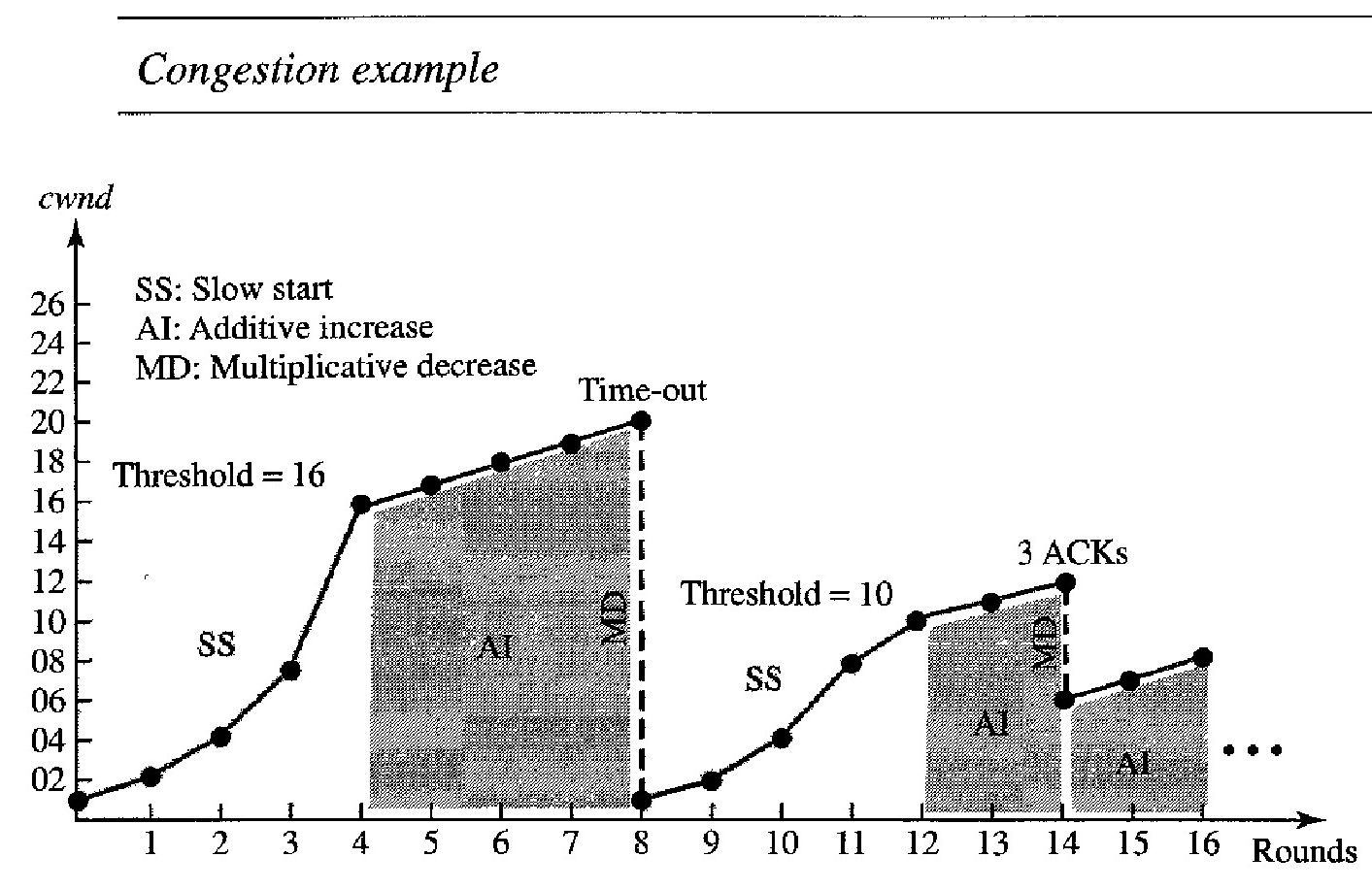CONGESTION CONTROL
Congestion control refers to techniques and mechanisms that can either prevent congestion, before it happens, or remove congestion, after it has happened. In general, we can divide congestion control mechanisms into two broad categories: open-loop congestion control (prevention) and closed-loop congestion control (removal).
Open-Loop Congestion Control : In open-loop congestion control, policies are applied to prevent congestion before it happens. In these mechanisms, congestion control is handled by either the source or the destination.
Retransmission Policy : Retransmission is sometimes unavoidable. If the sender feels that a sent packet is lost or corrupted, the packet needs to be retransmitted. Retransmission in general may increase congestion in the network. However, a good retransmission policy can prevent congestion. The retransmission policy and the retransmission timers must be designed to optimize efficiency and at the same time prevent congestion. For example, the retransmission policy used by TCP is designed to prevent or alleviate congestion.
Window Policy : The type of window at the sender may also affect congestion. The Selective Repeat window is better than the Go-Back-N window for congestion control. In the Go-Back-N window, when the timer for a packet times out, several packets may be resent, although some may have arrived safe and sound at the receiver. This duplication may make the congestion worse. The Selective Repeat window, on the other hand, tries to send the specific packets that have been lost or corrupted.
Acknowledgment Policy : The acknowledgment policy imposed by the receiver may also affect congestion. If the receiver does not acknowledge every packet it receives, it may slow down the sender and help prevent congestion. Several approaches are used in this case. A receiver may send an acknowledgment only if it has a packet to be sent or a special timer expires. A receiver may decide to acknowledge only N packets at a time. We need to know that the acknowledgments are also part of the load in a network. Sending fewer acknowledgments means imposing less load on the network.
Discarding Policy : A good discarding policy by the routers may prevent congestion and at the same time may not harm the integrity of the transmission. For example, in audio transmission, if the policy is to discard less sensitive packets when congestion is likely to happen, the quality of sound is still preserved and congestion is prevented or alleviated.
Admission Policy : An admission policy, which is a quality-of-service mechanism, can also prevent congestion in virtual-circuit networks. Switches in a flow first check the resource requirement of a flow before admitting it to the network. A router can deny establishing a virtual- circuit connection if there is congestion in the network or if there is a possibility of future congestion.
Closed-Loop Congestion Control : Closed-loop congestion control mechanisms try to alleviate congestion after it happens.
Backpressure : The technique of back pressure refers to a congestion control mechanism in which a congested node stops receiving data from the immediate upstream node or nodes. This may cause the upstream node or nodes to become congested, and they, in tum, reject data from their upstream nodes or nodes. And so on. Backpressure is a node-to-node congestion control that starts with a node and propagates, in the opposite direction of data flow, to the source. The backpressure technique can be applied only to virtual circuit networks, in which each node knows the upstream node from which a flow of data is corning. The technique cannot be implemented in a datagram network because in this type of network, a node (router) does not have the slightest knowledge of the upstream router.
Choke Packet : A choke packet is a packet sent by a node to the source to inform it of congestion. Note the difference between the backpressure and choke packet methods. In backpres- sure, the warning is from one node to its upstream node, although the warning may eventually reach the source station. In the choke packet method, the warning is from the router, which has encountered congestion, to the source station directly. The intermediate nodes through which the packet has traveled are not warned. We have seen an example of this type of control in ICMP. When a router in the Internet is overwhelmed with IP datagrams, it may discard some of them; but it informs the source host, using a source quench ICMP message. The warning message goes directly to the source station; the intermediate routers, and does not take any action.
Implicit Signaling : In implicit signaling, there is no communication between the congested node or nodes and the source. The source guesses that there is a congestion somewhere in the network from other symptoms. For example, when a source sends several packets and there is no acknowledgment for a while, one assumption is that the network is congested. The delay in receiving an acknowledgment is interpreted as congestion in the network; the source should slow down.
Explicit Signaling : The node that experiences congestion can explicitly send a signal to the source or desti- nation. The explicit signaling method, however, is different from the choke packet method. In the choke packet method, a separate packet is used for this purpose; in the explicit signaling method, the signal is included in the packets that carry data. Explicit signaling, as we will see in Frame Relay congestion control, can occur in either the forward or the backward direction.
Backward Signaling : A bit can be set in a packet moving in the direction opposite to the congestion. This bit can warn the source that there is congestion and that it needs to slow down to avoid the discarding of packets.
Forward Signaling : A bit can be set in a packet moving in the direction of the , congestion. This bit can warn the destination that there is congestion. The receiver in this case can use policies, such as slowing down the acknowledgments, to alleviate the the congestion.
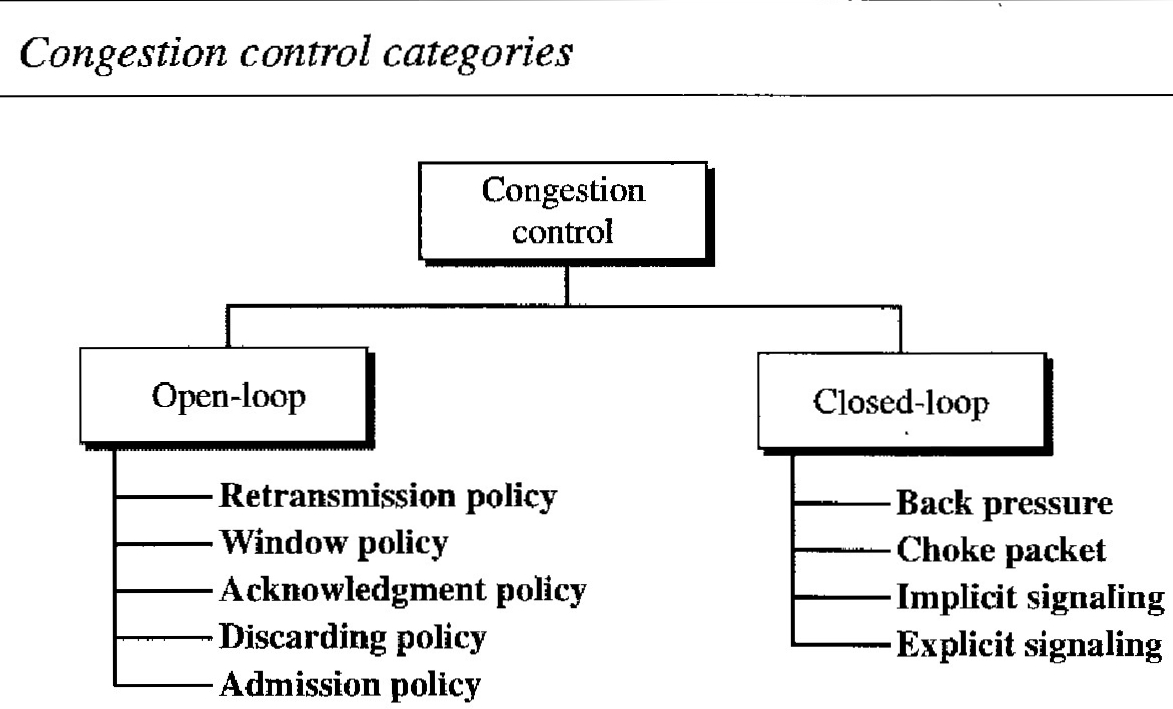
Congestion Control in TCP
We talked about flow control and tried to discuss solutions when the receiver is overwhelmed with data. We said that the sender window size is determined by the available buffer space in the receiver (rwnd).
In other words, we assumed that it is only the receiver that can dictate to the sender the size of the sender's window. We totally ignored another entity here-the network.
If the network cannot deliver the data as fast as they are created by the sender, it must tell the sender to slow down. In other words, in addition to the receiver, the network is a second entity that determines the size of the sender's window.
Today, the sender's window size is determined not only by the receiver but also by congestion in the network. The sender has two pieces of information: the receiver-advertised window size and the congestion window size. The actual size of the window is the minimum of these two.
Actual window size == minimum (rwnd, cwnd)
TCP's general policy for handling congestion is based on three phases: slow start, con- gestion avoidance, and congestion detection. In the slow-start phase, the sender starts with a very slow rate of transmission, but increases the rate rapidly to reach a threshold. When the threshold is reached, the data rate is reduced to avoid congestion. Finally if congestion is detected, the sender goes back to the slow-start or congestion avoidance phase based on how the congestion is detected.
One of the algorithms used in TCP congestion control is called slow start. This algorithm is based on the idea that the size of the con- gestion window (cwnd) starts with one maximum segment size (MSS). The MSS is determined during connection establishment by using an option of the same name. The size of the window increases one MSS each time an acknowledgment is received. As the name implies, the window starts slowly, but grows exponentially.
The sender starts with cwnd = 1 MSS. This means that the sender can send only one segment. After receipt of the acknowledgment for segment 1, the size of the congestion window is increased by 1, which means that cwnd is now 2. Now two more segments can be sent. When each acknowledgment is received, the size of the window is increased by 1 MSS. When all seven segments are acknowledged, cwnd= 8.
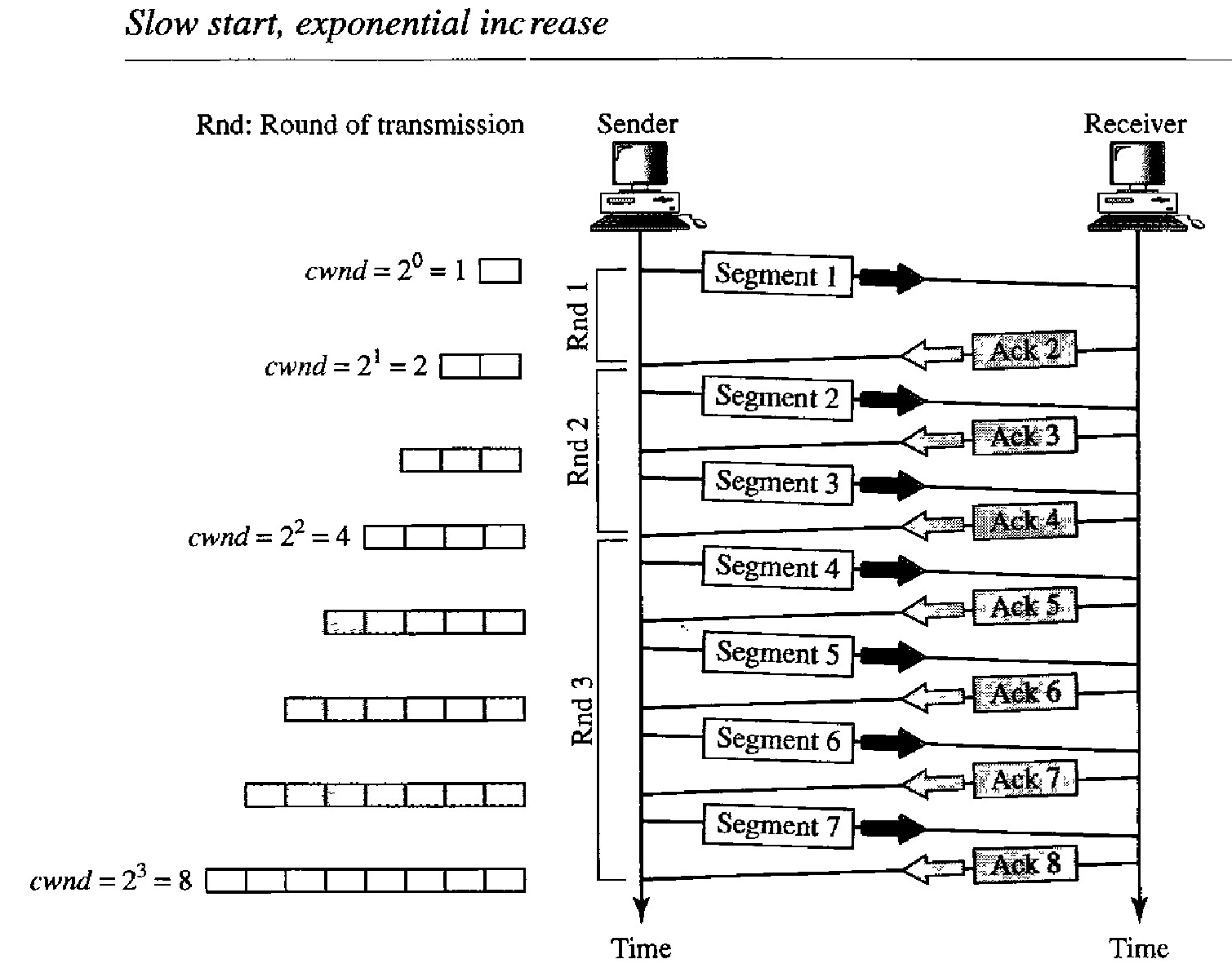
Example of Slow Start rate
If we look at the size of cwnd in terms of rounds (acknowledgment of the whole window of segments), we find that the rate is exponential as shown below:
Start ⇒ cwnd = 1
After Round 1 ⇒ cwnd = 21 = 2
After Round 2 ⇒ cwnd = 22 = 4
After Round 3 ⇒ cwnd = 23 = 8
Slow start cannot continue indefinitely. There must be a threshold to stop this phase. The sender keeps track of a variable named ssthresh (slow-start threshold).
When the size of window in bytes reaches this threshold, slow start stops and the next phase starts. In most implementations the value of ssthresh is 65,535 bytes.
We need to mention that if there is delayed ACKs, the increase in the size of the window is less than power of 2.
Congestion Avoidance: Additive Increase
If we start with the slow-start algorithm, the size of the congestion window increases exponentially. To avoid congestion before it happens, one must slow down this exponential growth.
TCP defines another algorithm called congestion avoidance, which undergoes an additive increase instead of an exponential one.
When the size of the congestion window reaches the slow-start threshold, the slow-start phase stops and the additive phase begins. In this algorithm, each time the whole window of segments is acknowledged (one round), the size of the congestion window is increased by 1.
To show the idea, we apply this algorithm to the same scenario as slow start, although we will see that the congestion avoidance algorithm usually starts when the size of the window is much greater than 1.
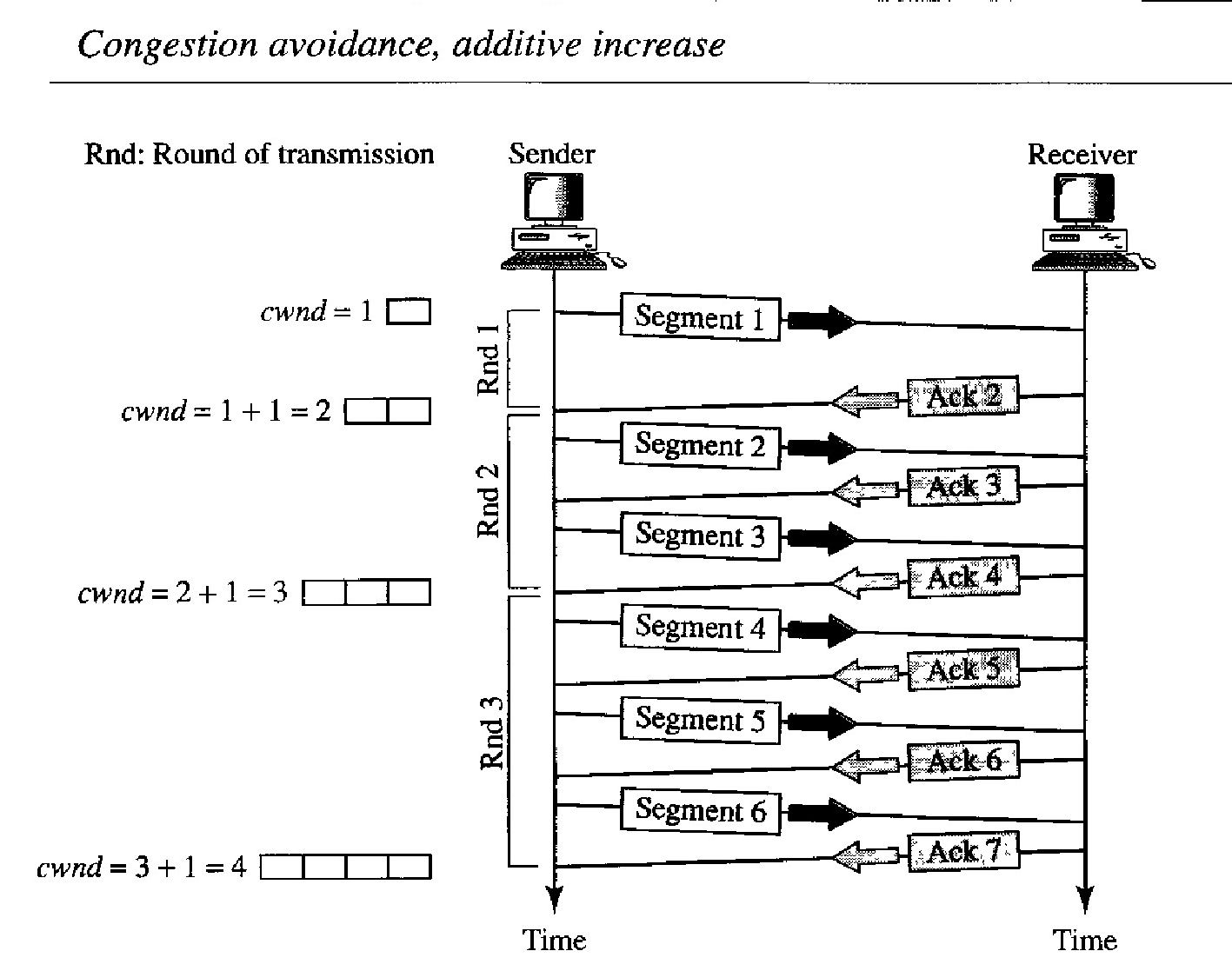
Example of Congestion Avoidance: Additive Increase
In this case, after the sender has received acknowledgments for a complete window size of segments, the size of the window is increased by one segment.
Start ⇒ cwnd = 1
After Round 1 ⇒ cwnd = 1 + 1 = 2
After Round 2 ⇒ cwnd = 2 + 1 = 3
After Round 3 ⇒ cwnd = 3 + 1 = 4
Congestion Detection: Multiplicative Decrease
If congestion occurs, the congestion window size must be decreased. The only way the sender can guess that congestion has occurred is by the need to retransmit a segment.
However, retransmission can occur in one of two cases: when a timer times out or when three ACKs are received. In both cases, the size of the threshold is dropped to one-half, a multiplicative decrease.
Most TCP implementations have two reactions:
If a time-out occurs, there is a stronger possibility of congestion; a segment has probably been dropped in the network, and there is no news about the sent segments.
In this case TCP reacts strongly:
It sets the value of the threshold to one-half of the current window size.
It sets cwnd to the size of one segment.
It starts the slow-start phase again.
If three ACKs are received, there is a weaker possibility of congestion; a segment may have been dropped, but some segments after that may have arrived safely since three ACKs are received. This is called fast transmission and fast recovery. In this case, TCP has a weaker reaction:
It sets the value of the threshold to one-half of the current window size.
It sets cwnd to the value of the threshold (some implementations add three segment sizes to the threshold).
It starts the congestion avoidance phase.
An implementations reacts to congestion detection in one of the following ways:
If detection is by time-out, a new slow-start phase starts.
If detection is by three ACKs, a new congestion avoidance phase starts.
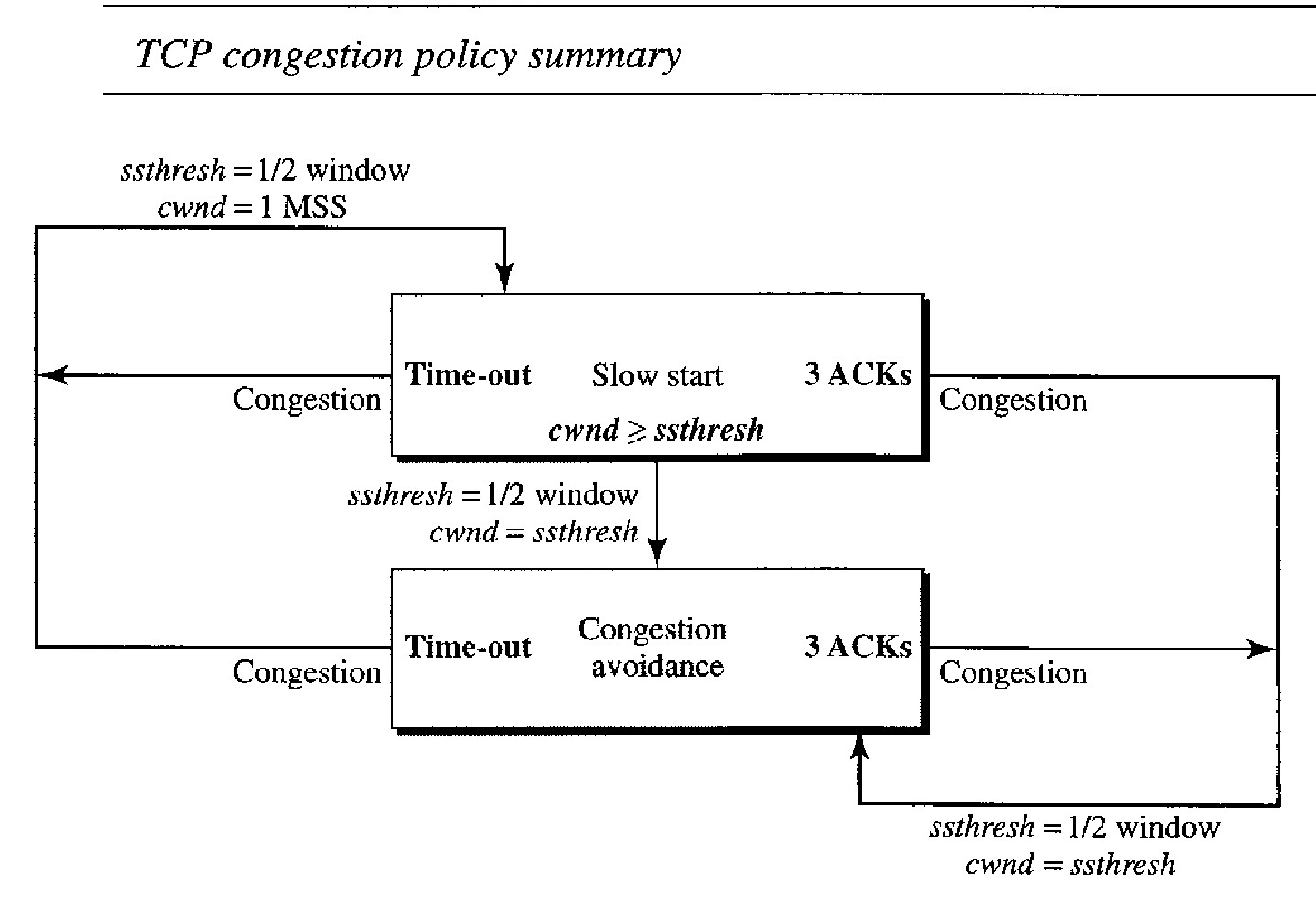
Example of TCP Congestion control policy
Congestion example is shown in Figure below. We assume that the maximum window size is 32 segments. The threshold is set to 16 segments (one-half of the maximum window size).
In the slow-start phase the window size starts from 1 and grows exponentially until it reaches the threshold. After it reaches the threshold, the congestion avoidance (additive increase) procedure allows the window size to increase linearly until a timeout occurs or the maximum window size is reached.
n Figure above, the time-out occurs when the window size is 20. At this moment, the multiplicative decrease procedure takes over and reduces the threshold to one-half of the previous window size. The previous window size was 20 when the time-out happened so the new threshold is now 10.
TCP moves to slow start again and starts with a window size of 1, and TCP moves to additive increase when the new threshold is reached. When the window size is 12, a three-ACKs event happens. The multiplicative decrease procedure takes over again. The threshold is set to 6 and TCP goes to the additive increase phase this time. It remains in this phase until another time-out or another three ACKs happen.
